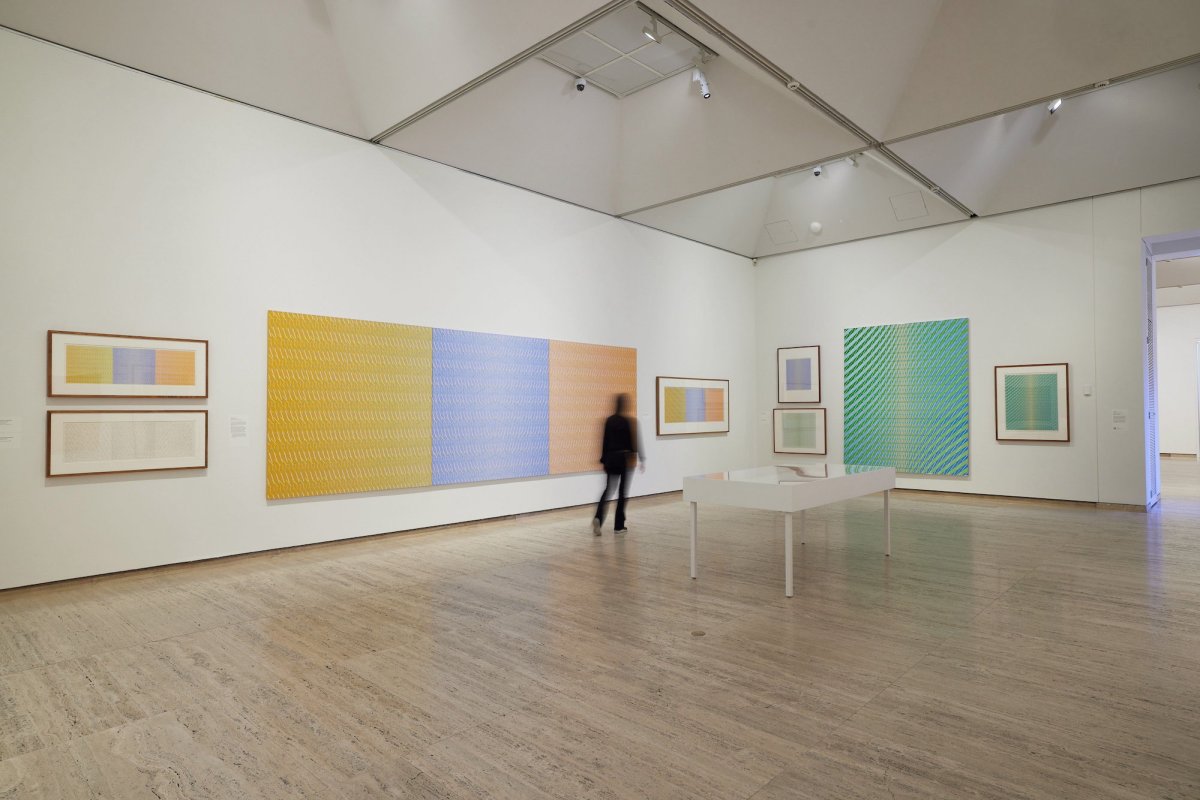Anne Ryan is such a sensitive and erudite curator and, while this exhibition, Thrum, is hung chronologically (appropriately for a survey exhibition), the energy and flow that can be sucked out with that rigid format, has been spared.
It is testament to the work itself, which holds the viewer from its earliest abstractions of the 1960s, to the most recent works made for this exhibition.
Spanning more than five decades, Lesley Dumbrell: Thrum presents over 90 paintings and works on paper that probe the nuances of colour, visual perception and our physical responses to them. What is more commonly known as optical art – that vibration we sense when viewing some rigorous abstract works – is a foundation that starts with her (largely male) peers in the 60s in the early history of this genre in Australia, but then moved through a journey where that energy was harnessed, and owned, as Dumbrell continued to push it and rethink it over the decades that followed.
Perhaps one of the most arresting moments in this survey is the bookend that it presents, with a newly commissioned water-jet-cut metal sculpture for the entry of the exhibition. It is an indication of where the work is heading, as Dumbrell steps into her eighties.
Descending the gallery’s escalator to the lower galleries, it appears as a flat abstraction in blues on a violet wall. As we sidle alongside it, it punches into three dimensions – its shadows becoming an active agent to completing it. What this wall-based sculpture does is talk about drawing.

And when they enter the first gallery – visitors will have that light bulb moment that connects to the earliest pieces Dumbrell made as a young woman in Melbourne. Simple, it has always been about drawing.
This first gallery is very active for that sense of vibration. Dotted between the painting and in a museum case that sits central to the room are the drawn studies for these paintings. Ryan has placed a similar case in each of the rooms that focus on a decade – some highly resolved works on paper and others unfinished. What they do is offer a window to Dumbrell’s process. She meticulously plans out every painting on grid paper, blocking out the colour.

In an interesting twist, we even witness how she builds her palette – moving left to right on the page – rather than working up one colour at a time. It is instructive in that sense that these completed works are totally visualised in her head – mind-blowing complex compositions to any other person.
In the first galleries, the works are largely experiments in expansion and contraction – as colour and line concertina out and then pull in. They are all painted by hand – no tape is used – and in some you can even see the soft gentle brushiness of the colour fields.
Dumbrell got her footing at the time of the famed The Field exhibition in Melbourne, but was not fazed by being overlooked. She told Ryan that it gave her a freedom to just get on with her work without being observed at that early moment in her career.
Needless to say, scanning across all six decades of her making, Dumbrell always painted at scale and with a confidence that was on par with her peers.
In some ways, this survey could be decried as long overdue. Dumbrell has been supported across her career, but just hasn’t had the lens of an institutional monograph until now. A large number of the loans come from the National Gallery of Australia, collected under inaugural director James Mollison, who had a reputation for an intuitive eye, and for collecting in depth. He recognised Dumbrell’s talent early and – as this exhibition testifies – we are grateful to have that depth of holdings today, especially these studies that are so rare.
Read: Exhibition review: Angelica Mesiti: The Rites of When, AGNSW
It goes without saying, Gallery Two looks at the 70s, Gallery Three the 80s and so on, finishing up with Dumbrell’s more recent works. The tone shifts subtly – to a fine eye, dramatically – but any viewer can attest to the freshness that has remained across her entire oeuvre.
These paintings are so incredibly crisp. They are spatially complex and incredible studies in colour and, as we reach these last decades, we can almost start to see the scaffold of their sculptural form starting to emerge. I am thinking of a painting of ‘computer green’ on a black field, weaving depth into its flat surface.
Overall, this exhibition delights and seduces. Many will revisit paintings that are familiar across our major state collections and now, seen en masse, will make sense as a life’s work.
Lesley Dumbrell: Thrum
Art Gallery of New South Wales, Naala Nura – south building
20 July to 13 October 2024.
Entry is free.





